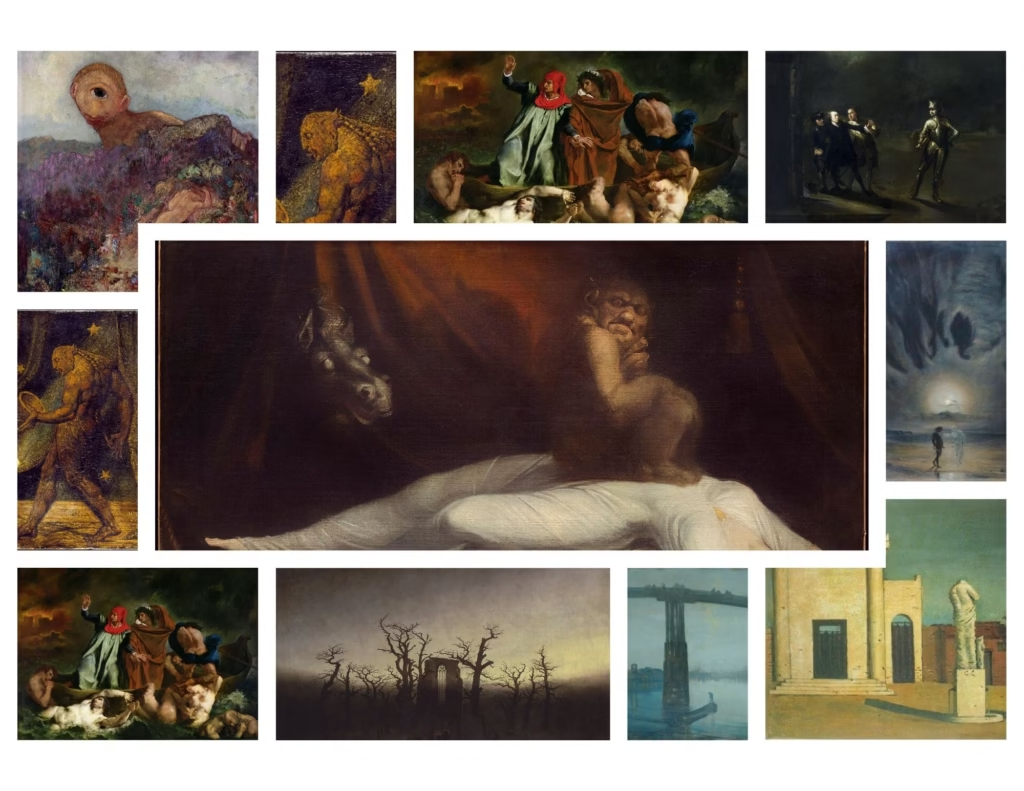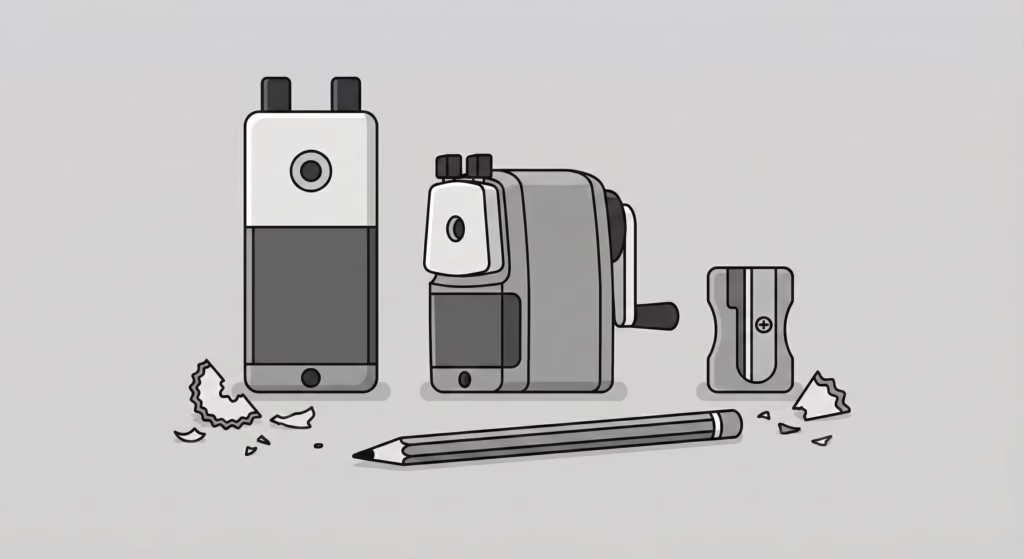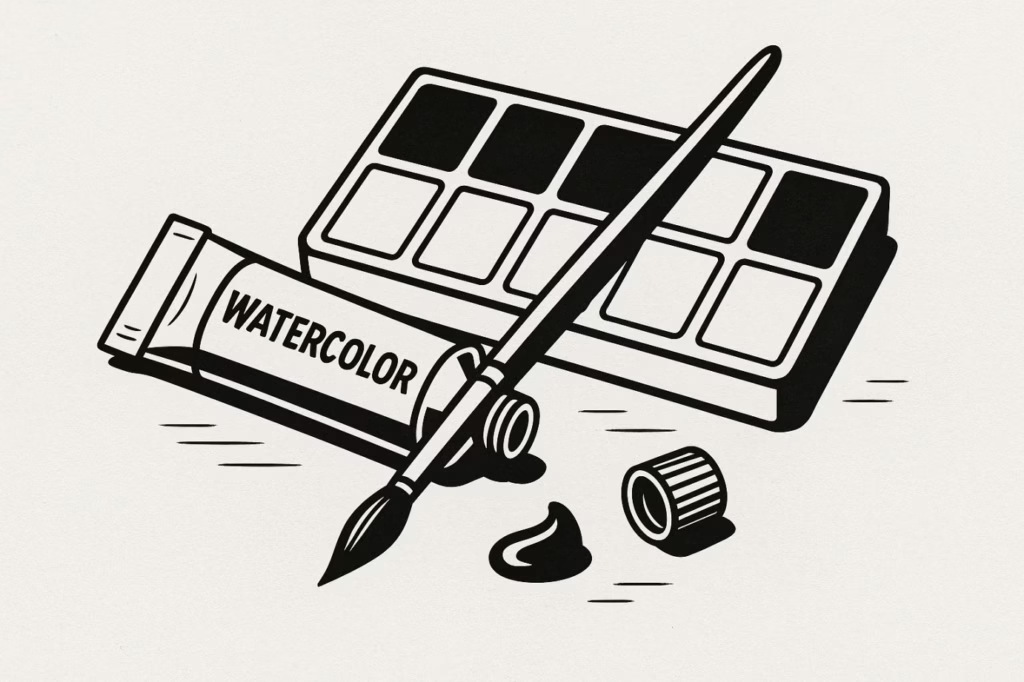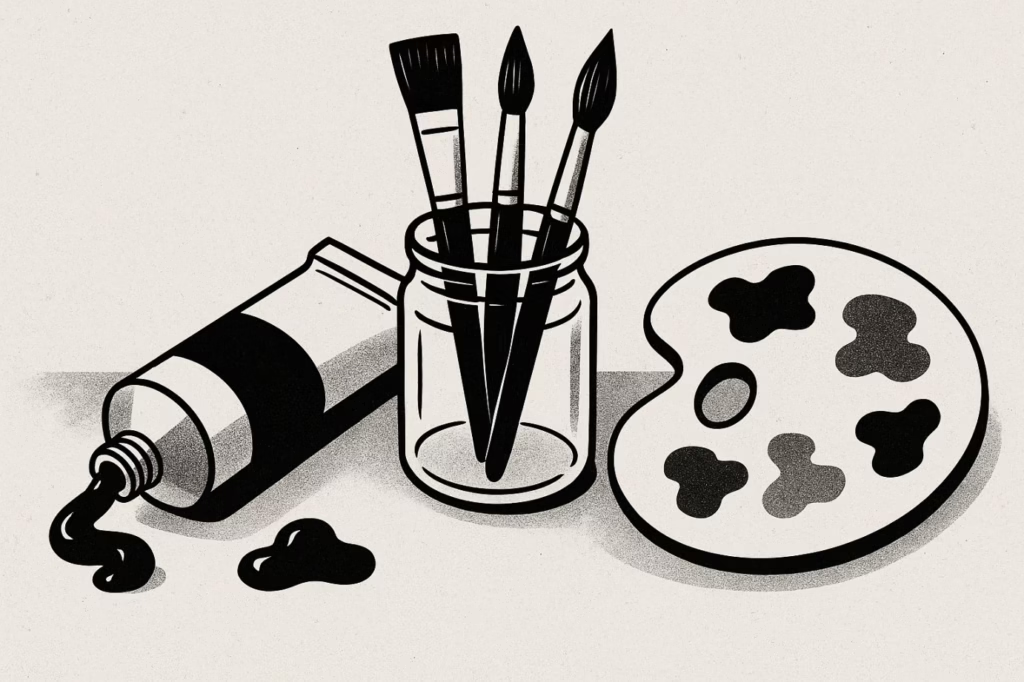Step into the shadowy corridors of art history, where masters of the canvas dared to paint what lurks beyond the veil of death. When exploring the 10 most haunting ghosts in classic art, we discover more than mere artistic imagination—these are windows into the supernatural realm that have terrified and fascinated viewers for centuries.
Picture this: You’re standing alone in a dimly lit museum hall at closing time. The security guard’s footsteps echo in the distance. Suddenly, you notice something unsettling about the painting before you—the eyes seem to follow your movement, and what you initially thought was a shadow appears to shift and breathe. Welcome to the world of supernatural art, where the greatest masters in history captured not just light and form, but spirits, demons, and creatures that exist between worlds.
Throughout art history, painters have been drawn to the mysterious realm of the supernatural like moths to a flickering candle. From medieval manuscripts depicting dancing skeletons to Romantic paintings of ghostly apparitions, artists have long served as translators of the invisible world. But some works transcend mere representation—they seem to contain actual spirits, as if the artist’s brush became a conduit for otherworldly forces.
Today, we embark on a spine-tingling journey through the 10 most haunting ghosts in classic art. These aren’t just paintings with spooky themes—these are masterpieces where the supernatural becomes tangible, where every brushstroke seems possessed by an ethereal presence that continues to unsettle viewers centuries after their creation.
1. William Blake – “The Ghost of a Flea” (1819-1820)
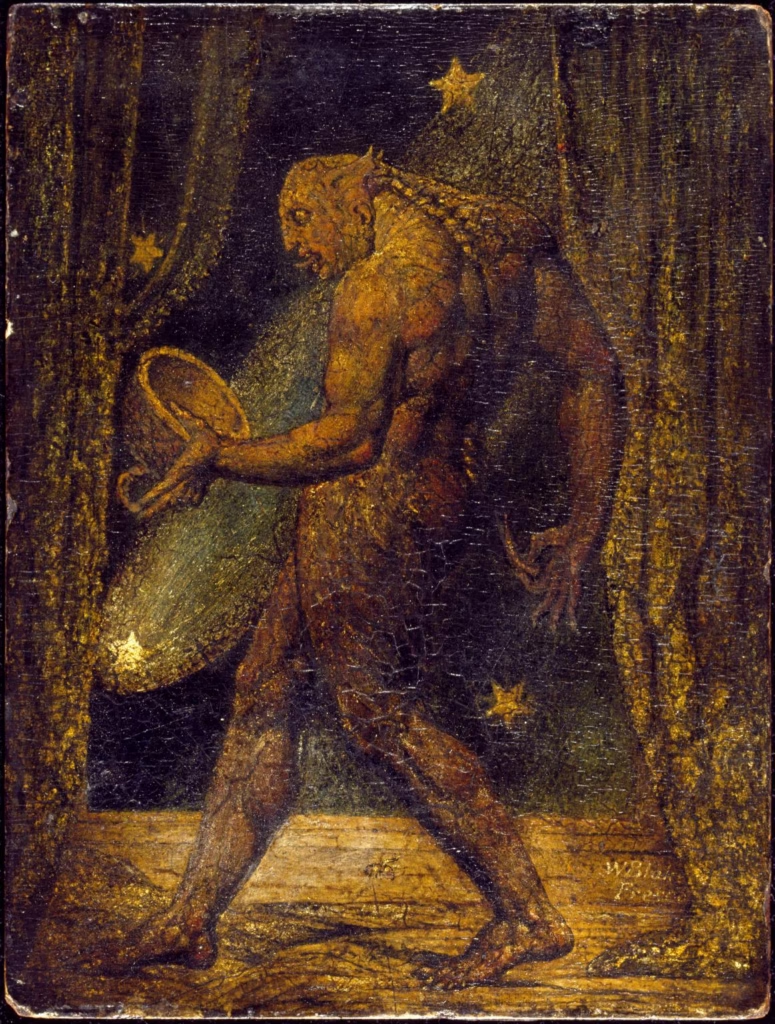
The Most Haunting Ghosts in Classic Art Begin with Blake’s Supernatural Vision
In a small tempera painting barely larger than a playing card lies one of art history’s most bizarre and terrifying visions. William Blake’s “The Ghost of a Flea” depicts a muscular, humanoid creature with the head of a flea, clutching a bowl of blood while its forked tongue darts toward the crimson liquid. This masterpiece stands as perhaps the most authentic supernatural artwork among the 10 most haunting ghosts in classic art, born not from imagination but from genuine paranormal encounter.
The Séance That Changed Art History
The story begins in 1819 when Blake attended séances with his friend John Varley, a fellow artist and astrologer. During one session, Blake claimed to see the spirit of a flea manifest before him. As he sketched frantically, the spectral insect supposedly spoke to him, revealing that fleas were inhabited by the souls of bloodthirsty men who, in life, had been “by nature bloodthirsty to excess.”
Blake’s ghost-flea explained that if these creatures had human-sized bodies, they would depopulate nations. The painting shows this terrifying transformation—a flea with human musculature and supernatural strength, its eyes gleaming with predatory intelligence.
For more insights into Blake’s visionary art, explore the Tate Gallery’s Blake collection and discover how this master captured spiritual visions throughout his career.
Artistic Brilliance Meets Spiritual Vision
What makes this painting extraordinary isn’t just its bizarre subject matter, but Blake’s technical mastery in depicting the impossible. The creature’s anatomy is perfectly rendered despite being anatomically impossible. Golden light emanates from behind heavy curtains, suggesting this vision exists in a realm between our world and the next. The flea-spirit’s posture—simultaneously human and insectoid—creates an unsettling cognitive dissonance that has disturbed viewers for over two centuries.
Blake painted this during his series of “Visionary Heads,” all allegedly inspired by supernatural encounters. Unlike his contemporaries who painted religious or mythological subjects, Blake claimed direct communication with the spirit world, making him perhaps history’s first artist to create work through paranormal collaboration.
2. Hieronymus Bosch – “The Garden of Earthly Delights” (Hell Panel, 1490-1510)
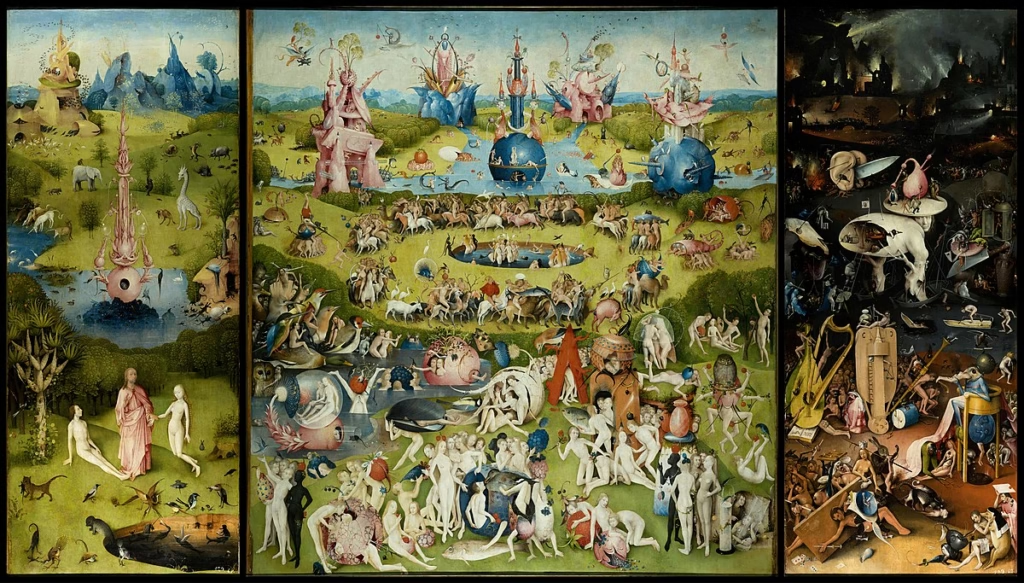
Source: Wikipedia
Demonic Spirits That Define The Most Haunting Ghosts in Classic Art
If Blake’s flea-ghost is unsettling, Bosch’s Hell panel represents the most comprehensive supernatural invasion in art history. This rightmost panel of Bosch’s famous triptych presents a landscape so populated with demonic spirits that it secures its position among the 10 most haunting ghosts in classic art through sheer overwhelming supernatural presence.
A Demonic Orchestra of Torment
The centerpiece of this hellish vision is a grotesque bird-headed demon seated on a throne-like commode, eternally devouring sinners and excreting them into a pit below. This creature, often interpreted as Satan himself, wears a cauldron as a blasphemous crown, his legs planted in smaller vessels. Around him, a symphony of supernatural torture unfolds.
Musical instruments become tools of demonic punishment: a harp crucifies its player, a lute binds a sinner with serpentine strings, and drums trap souls within their hollow chambers. A demon with the head of a pig dressed as a nun tempts a sinner to sign a contract with the Devil, while her bird-headed companion provides the diabolic ink.
The Nightmare’s Technical Mastery
What transforms this from mere horror illustration to high art is Bosch’s incredible attention to detail and symbolic complexity. Every demon serves a purpose in his theological vision. The giant ears pierced by knives represent the deceptive lure of flattery and gossip. The bladder-like creatures floating through the scene symbolize the emptiness of earthly pleasures.
Bosch painted this masterpiece during the height of the Northern Renaissance, when belief in demons and devils was literal reality for most people. His supernatural creatures weren’t fantasy—they were documentary evidence of the spirit world’s terrible inhabitants, painted by an artist who seemed to have unprecedented access to hell’s bureaucracy.
The Museo del Prado houses this masterpiece and provides detailed analysis of Bosch’s revolutionary techniques for depicting supernatural realms.
Modern Supernatural Influence
Centuries later, Surrealist artists like Salvador Dalí would appropriate Bosch’s imagery, but none matched the original’s sense of genuine supernatural presence. The painting continues to inspire horror films, heavy metal album covers, and contemporary artists who recognize in Bosch’s demons something that transcends mere artistic imagination.
3. Johann Heinrich Füssli – “The Nightmare” (1781)
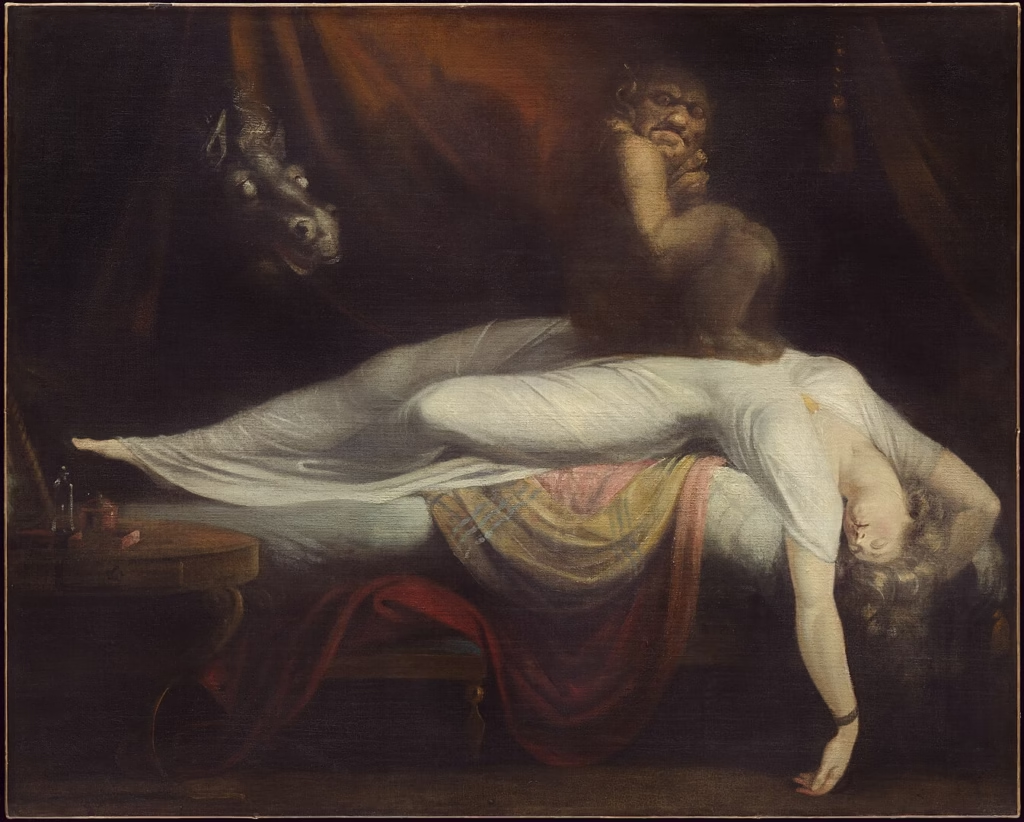
Source: Wikipedia
Sleep Paralysis Spirits Among The Most Haunting Ghosts in Classic Art
Perhaps no painting has more perfectly captured the experience of supernatural terror than Füssli’s “The Nightmare.” This work doesn’t just depict a ghost—it manifests the very essence of nocturnal horror, earning its place among the 10 most haunting ghosts in classic art by creating an image so psychologically disturbing that it became a symbol for supernatural attack itself.
When Art Meets Paranormal Psychology
The scene is deceptively simple: a woman in white lies unconscious across a bed, her head and arms dangling over the edge in complete vulnerability. Crouched on her chest sits a goblin-like creature—the “nightmare” or incubus—grinning malevolently at the viewer with glowing eyes. Behind them, a ghostly horse with luminous eyes pushes through heavy curtains, its expression equally menacing.
What makes this supernatural? Füssli didn’t paint a fantasy—he documented a genuine paranormal phenomenon. The incubus was believed to be a male demon that sexually assaulted sleeping women, causing the crushing chest sensation and terrifying hallucinations we now know as sleep paralysis. The horse represents the “mare” in nightmare, an evil spirit that rode on sleepers’ chests.
The Artist’s Personal Haunting
Recent scholarship suggests Füssli painted his own supernatural experiences. The artist suffered from chronic nightmares and claimed to eat raw pork chops before bed to induce vivid dreams. Some art historians believe the demon represents Füssli himself, channeling his unrequited love for Anna Landolt (whose portrait appears on the canvas’s reverse side) into this scene of supernatural violation.
The painting’s composition amplifies its ghostly power. The dramatic chiaroscuro lighting creates deep shadows where additional spirits might hide. The woman’s pale, luminous flesh contrasts with the demon’s dark, hairy form, suggesting the eternal battle between purity and corruption, life and death.
Cultural Haunting
“The Nightmare” became so influential that it spawned countless imitations, parodies, and references. It appeared in political cartoons, horror films, and contemporary art installations. The painting seems to possess its own supernatural ability to reproduce itself across cultures and centuries, as if Füssli’s original demons continue to seek new victims through artistic reproduction.
4. Caspar David Friedrich – “Abbey in the Oakwood” (1809-1810)
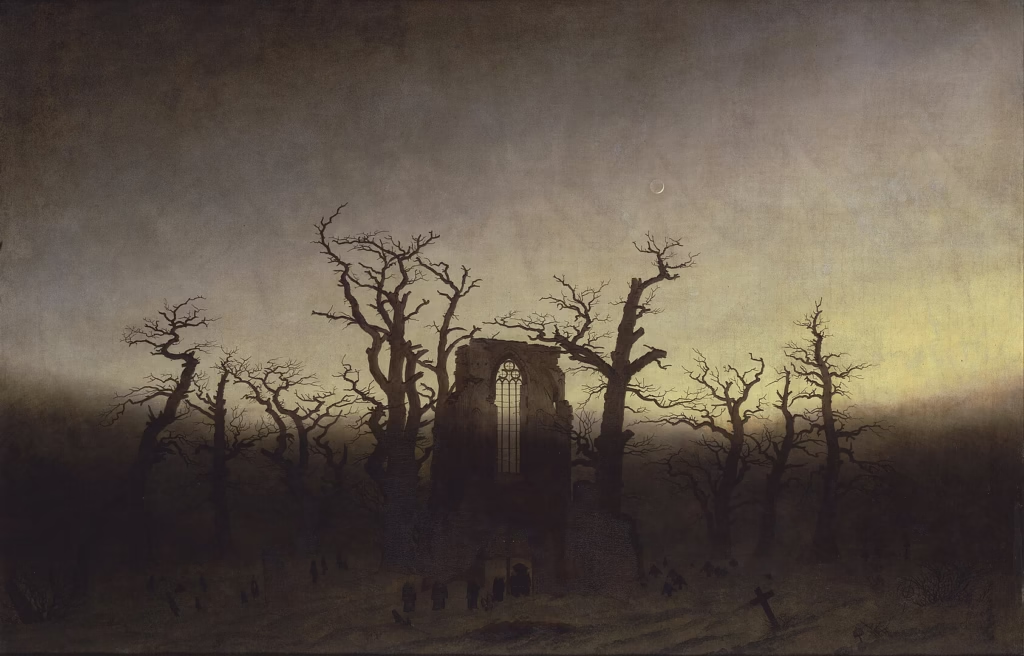
Source: Wikipedia
Friedrich’s masterpiece presents a different kind of supernatural presence—not demons or monsters, but the ghosts of faith itself. In this hauntingly beautiful landscape, the ruins of a Gothic abbey stand silhouetted against a winter sky, surrounded by gnarled oak trees and populated by barely visible figures conducting a funeral procession.
Spirits of the Romantic Sublime
What makes this painting supernatural isn’t obvious ghostly figures but its profound sense of spiritual presence. The ruined abbey represents the death of medieval Christianity, yet something sacred lingers among the stones. The oak trees, symbols of endurance and wisdom in Germanic folklore, stand like ancient spirits witnessing the procession below.
The tiny figures carrying a coffin toward the abbey ruins suggest souls crossing from life to death, from the material world to the spiritual realm. Friedrich painted this during the height of German Romanticism, when artists believed nature itself was a manifestation of the divine—and the supernatural.
Gothic Revival and Spiritual Longing
Friedrich’s genius lies in making the invisible visible through pure atmosphere. The painting contains no explicit ghosts, yet viewers consistently report feeling watched by unseen presences. The broken Gothic windows frame emptiness that seems pregnant with spiritual possibility. The winter setting suggests death, but also the promise of spiritual renewal.
This work influenced generations of artists exploring the supernatural through landscape. The abbey’s ruins don’t just represent architectural decay—they house the spirits of centuries of prayer, creating a palimpsest where past and present, living and dead, occupy the same sacred space.
5. Alfred Munnings – “The Haunted Room” (1952)
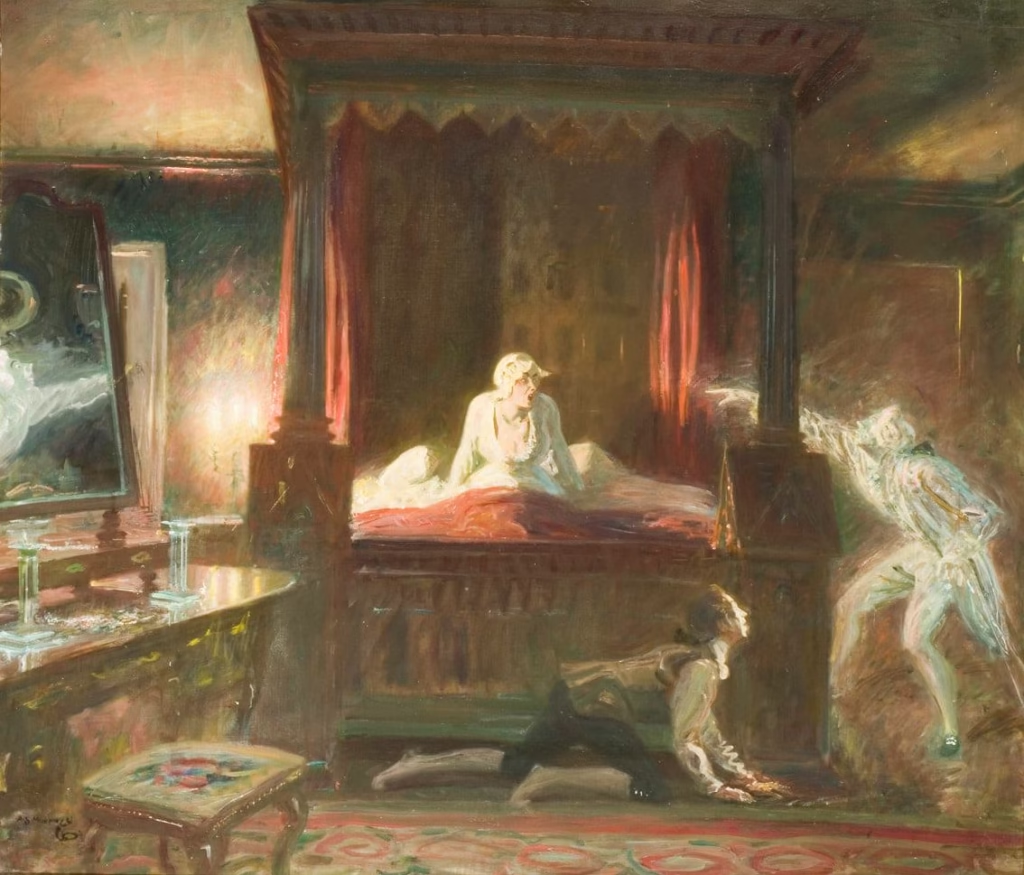
Source: Wikipedia
In a shocking departure from his celebrated equestrian paintings, Alfred Munnings created one of the 20th century’s most genuinely unsettling supernatural scenes. “The Haunted Room” depicts a bedroom where something has clearly gone terribly wrong, with ghostly implications that continue to disturb viewers decades after its creation.
A Ghost Story in Paint
The scene shows a bedroom in apparent chaos. A man lies on the floor, seemingly dead or unconscious, while a figure remains in the bed. The room’s atmosphere suggests supernatural intervention—objects appear disturbed by invisible forces, and the lighting creates shadows that seem to move independently.
When exhibited at the Royal Academy in 1952, the painting caused a sensation. Viewers demanded explanations from Munnings, who remained deliberately vague. He suggested the man might have been “run through in a duel” by a ghost, but the painting’s ambiguity allows multiple supernatural interpretations.
The Cursed Bed
Adding to the work’s supernatural credibility, Munnings used an actual bed from Littlecote Hall in Wiltshire, reputedly haunted by the ghost of Wild Will Darrell, who murdered an infant there. The bed itself carried a dark history, and Munnings claimed he could feel its malevolent influence while painting.
The artist’s technique emphasizes the room’s ghostly atmosphere. Loose brushwork suggests movement where none should exist, and the color palette shifts between warm flesh tones and cold, deathly grays. The painting feels like a crime scene where the criminal was supernatural.
Departure from Convention
“The Haunted Room” represents Munnings’ only serious exploration of supernatural themes, making it all the more powerful. His usual sunny equestrian scenes give no indication he possessed such capacity for depicting otherworldly horror. The painting suggests that even the most conventional artists can be visited by supernatural inspiration—or possession.
6. Eugène Delacroix – “Dante and Virgil in Hell” (1822)
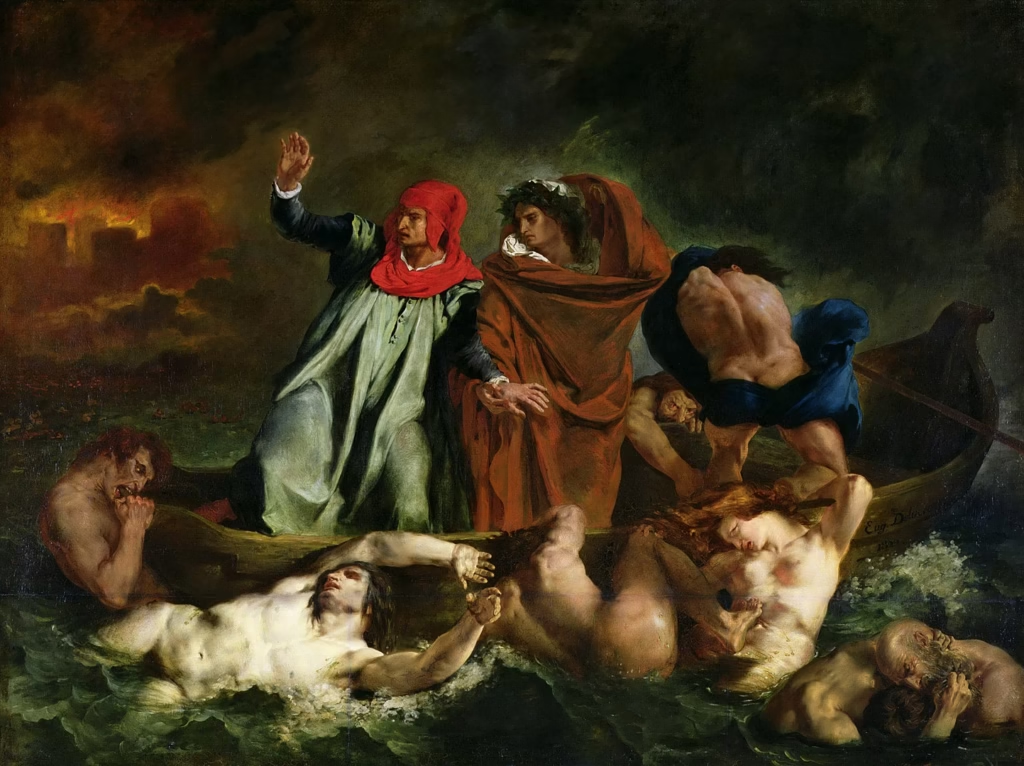
Source: Wikipedia
Delacroix’s early masterpiece transforms Dante’s literary vision of Hell into a visceral supernatural reality. The painting depicts the poets Dante and Virgil crossing the river Styx, surrounded by the damned souls who populate the underworld’s first circle. But these aren’t mere literary characters—Delacroix painted them as genuine supernatural entities.
Literary Ghosts Made Flesh
The central drama focuses on two damned souls locked in eternal combat. Ugolino gnaws on the skull of Archbishop Ruggieri, his betrayer, while other spectral figures writhe in the background waters. These aren’t metaphorical representations—they’re portraits of actual supernatural beings as Delacroix imagined them inhabiting the spirit world.
Delacroix’s revolutionary technique emphasizes the scene’s otherworldly nature. His loose brushwork and dramatic color contrasts create figures that seem to emerge from and dissolve back into supernatural mist. The boat carrying Dante and Virgil appears to float not on water but on a sea of tormented spirits.
Romantic Supernatural Vision
This painting established Delacroix as a master of supernatural subject matter and influenced generations of artists exploring similar themes. His Hell feels genuinely otherworldly, populated by beings that exist according to different physical laws than our material world.
The work’s supernatural power comes from Delacroix’s ability to make Dante’s imaginative geography feel like documentary evidence of the afterlife’s actual appearance. Viewers don’t just see literary characters—they witness genuine ghostly inhabitants of the underworld.
7. Arnold Böcklin – “Isle of the Dead” (1880)
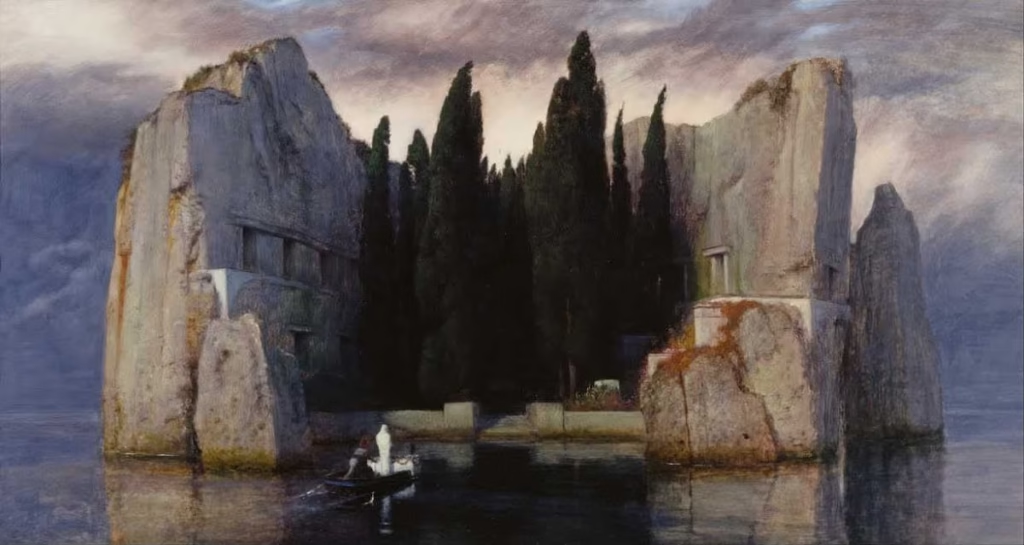
Source: Wikipedia
Böcklin’s haunting landscape presents perhaps art history’s most famous depiction of the boundary between life and death. The painting shows a mysterious island dominated by dark cypress trees, with a small boat carrying a white-shrouded figure and a coffin approaching its shore.
Gateway to the Spirit World
The island serves as a metaphor for death itself, but Böcklin painted it as a real place that viewers might actually visit. The cypress trees, traditional symbols of mourning, stand like sentries guarding whatever lies beyond. The rocky cliffs contain cave-like openings that suggest crypts or passages to the underworld.
The boat’s passenger, dressed in white, appears to be either a ghost conducting a soul to its final rest or Death itself ferrying the deceased. The figure’s ambiguity adds to the painting’s supernatural power—we can’t determine whether we’re witnessing a funeral procession or a ghostly visitation.
Symbolist Supernatural Philosophy
Böcklin belonged to the Symbolist movement, which believed art should represent invisible spiritual realities rather than mere physical appearances. “Isle of the Dead” doesn’t just depict a fantasy landscape—it provides a window into the actual geography of death, painted by an artist who claimed intuitive knowledge of the spirit world.
The painting’s influence extended far beyond art. It inspired musical compositions, literary works, and psychological analyses. Freud kept a reproduction in his office, recognizing in Böcklin’s island a genuine representation of humanity’s unconscious relationship with death and the supernatural.
8. James McNeill Whistler – “Nocturne in Blue and Gold: Old Battersea Bridge” (1872-1875)
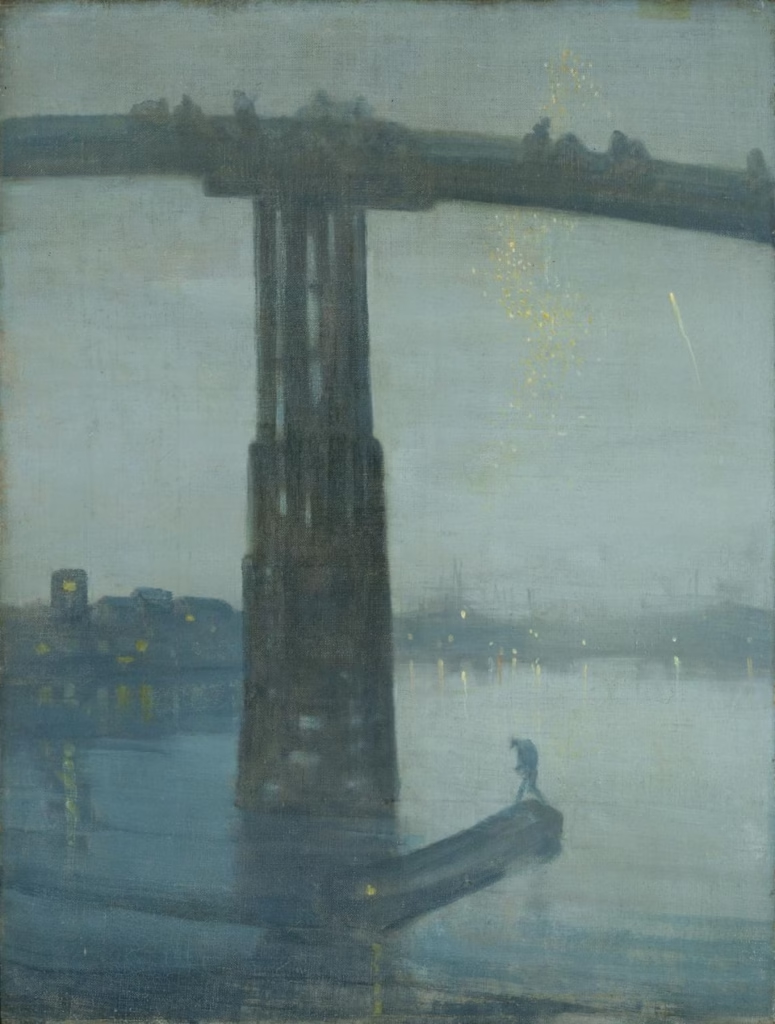
Whistler’s atmospheric night scene transforms a simple Thames landscape into a ghostly vision where the boundary between material and spiritual worlds dissolves. The painting shows Old Battersea Bridge at twilight, but the artist’s technique creates an image that seems populated by supernatural presences.
Atmospheric Ghosts
Whistler’s revolutionary approach to painting nocturnal scenes involved building up thin layers of paint to create atmospheric effects that suggest more than they reveal. In “Nocturne in Blue and Gold,” the bridge’s vertical posts emerge from mist like spectral guardians, while the boat below appears to float on supernatural rather than natural water.
The painting’s ghost-like quality comes from Whistler’s ability to capture the liminal moment when day becomes night, when familiar objects become mysterious and potentially otherworldly. The bridge itself seems to exist in multiple dimensions simultaneously—solid enough to serve its function but ethereal enough to house spirits.
Spiritual Impressionism
Whistler pioneered a form of atmospheric painting that influenced later artists exploring supernatural themes. His technique of suggesting rather than defining forms creates spaces where viewers’ imaginations can populate the shadows with ghostly presences.
The “Nocturne” series established a new artistic vocabulary for depicting the supernatural through pure atmosphere rather than explicit imagery. Whistler proved that ghosts don’t need to be painted directly—they can be summoned through color, light, and the viewer’s imagination.
9. Odilon Redon – “The Cyclops” (1914)
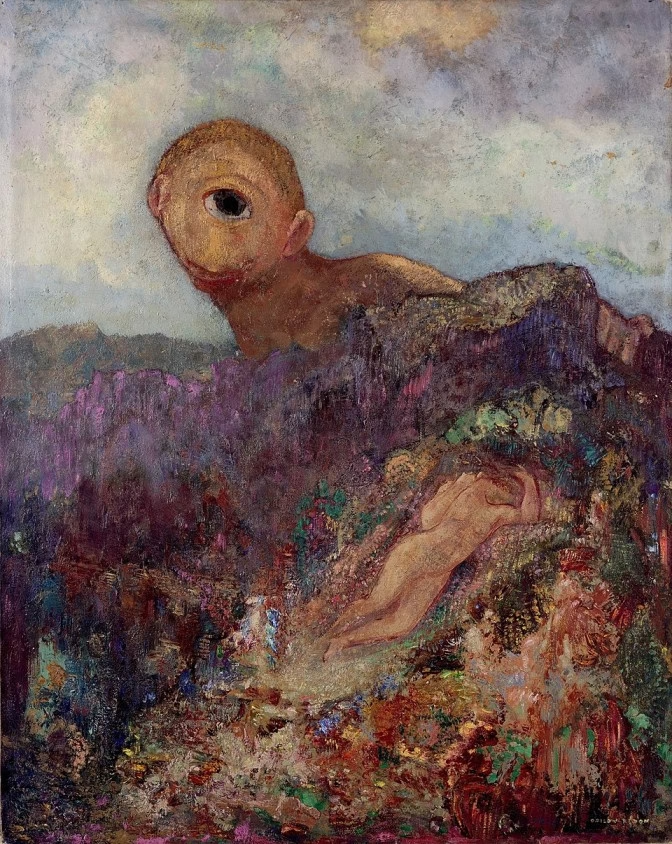
Source: Wikipedia
Redon’s late masterpiece presents a supernatural creature from Greek mythology, but the artist’s unique approach transforms the cyclops into something that feels genuinely otherworldly rather than merely fantastical. The giant’s single eye peers over a mountainous landscape where a tiny nude figure reclines, unaware of the supernatural gaze upon her.
Mythological Spirits Made Real
Redon spent decades exploring supernatural subjects through his distinctive combination of symbolism and psychological insight. “The Cyclops” represents the culmination of this exploration, presenting a being that exists in the realm of dreams and nightmares rather than classical mythology.
The cyclops’s eye dominates the composition, glowing with supernatural intelligence and desire. This isn’t a monster from ancient stories but a living spirit that seems to inhabit the painting itself. The creature’s flesh merges with the landscape, suggesting a being composed of earth and spirit rather than mere matter.
Symbolist Supernatural Technique
Redon’s technique emphasizes the cyclops’s otherworldly nature. His use of pastels creates colors that seem to emit their own light, giving the creature a luminous quality that suggests supernatural rather than natural illumination. The landscape around the cyclops appears to shift and breathe, as if responding to the presence of this powerful spirit.
The painting influenced later Surrealist explorations of supernatural themes, but Redon’s cyclops possesses a spiritual gravitas that transcends mere fantasy. This is a portrait of an actual mythological being as it might appear to someone with genuine psychic sight.
10. Giorgio de Chirico – “The Enigma of an Autumn Afternoon” (1910)
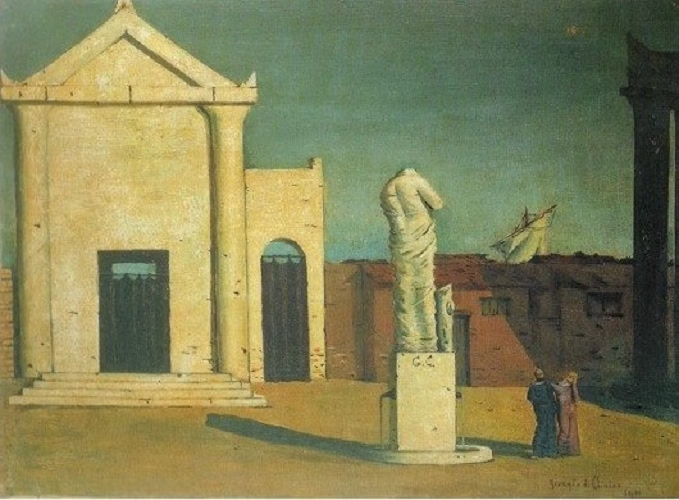
Source: Wikipedia
De Chirico’s metaphysical masterpiece doesn’t depict ghosts directly but creates an atmosphere so saturated with supernatural presence that viewers feel haunted by what isn’t shown. The painting presents an empty piazza with classical architecture, long shadows, and a sense of abandonment that suggests recent supernatural activity.
Invisible Supernatural Presence
The power of “The Enigma of an Autumn Afternoon” lies in its suggestion of ghostly presence through absence. The empty arcade and vacant piazza feel recently abandoned, as if invisible spirits have just departed or are watching from just outside the frame. The long shadows cast by unseen buildings create geometric patterns that seem to trace supernatural rather than natural light.
De Chirico pioneered “metaphysical painting,” which sought to reveal the hidden spiritual reality behind ordinary appearances. His empty spaces don’t represent abandonment but the presence of invisible forces that normal vision cannot detect.
Architectural Spirits
The classical buildings in de Chirico’s painting seem possessed by their own spirits—architectural ghosts that inhabit spaces long after their human occupants have departed. The arcade’s repeated arches create a rhythm that suggests breathing or heartbeat, giving the inanimate structure organic, supernatural life.
This painting influenced Surrealist artists who recognized in de Chirico’s empty spaces a new way of representing supernatural presence. Rather than painting ghosts directly, he created environments where ghosts might naturally appear, making viewers complicit in populating his empty world with spectral inhabitants.
The Psychology of Supernatural Art: Why The Most Haunting Ghosts in Classic Art Endure
Understanding The 10 Most Haunting Ghosts in Classic Art Through Cultural Context
Throughout history, artists have been drawn to supernatural subjects for reasons that extend beyond mere aesthetic choice. The 10 most haunting ghosts in classic art represent humanity’s attempt to visualize the invisible, to give form to our deepest fears and spiritual longings through masterful artistic technique.
Cultural and Religious Influences
Medieval artists painted demons and saints because supernatural beings were accepted reality in their world. Renaissance masters explored classical mythology’s spirits and gods as part of humanistic education. Romantic artists turned to ghosts and supernatural landscapes as expressions of individual spiritual experience rather than collective religious doctrine.
Each era’s supernatural art reflects its particular relationship with the invisible world. Gothic artists populated their paintings with demons because Hell seemed more real than Heaven. Symbolist painters created atmospheric spirits because they believed reality itself was essentially spiritual.
Artistic Techniques for Creating Supernatural Atmosphere
Master painters developed specific techniques for creating supernatural presence:
- Chiaroscuro lighting creates dramatic contrasts that suggest otherworldly illumination
- Atmospheric perspective allows figures to emerge from and dissolve into spiritual mist
- Ambiguous forms let viewers’ imaginations populate shadows with ghostly presences
- Symbolic color uses specific hues associated with death, spirits, and supernatural states
- Compositional dynamics create visual tension that mirrors psychological unease
The Psychology of Supernatural Fear
These paintings endure because they tap into universal psychological experiences: fear of death, curiosity about the afterlife, and fascination with the unknown. They provide safe spaces for experiencing supernatural terror, allowing viewers to confront their deepest fears through aesthetic experience.
Modern neuroscience suggests that supernatural art activates the same brain regions involved in actual fear responses, explaining why centuries-old paintings can still genuinely frighten contemporary viewers. These works don’t just represent ghosts—they create ghostly experiences.
Interactive Challenge: Test Your Ghost Art Knowledge
Now that you’ve journeyed through the 10 most haunting ghosts in classic art, test your knowledge with these thought-provoking questions:
- Which artist claimed to paint spirits he encountered during séances?
- A) Caspar David Friedrich
- B) William Blake
- C) Giorgio de Chirico
- D) Odilon Redon
- What supernatural phenomenon does Füssli’s “The Nightmare” document?
- A) Demonic possession
- B) Sleep paralysis and incubus attacks
- C) Ghostly apparitions
- D) Witchcraft rituals
- Which painting features a bed with an actual haunted history?
- A) “The Ghost of a Flea”
- B) “The Nightmare”
- C) “The Haunted Room”
- D) “Abbey in the Oakwood”
(Answers: 1-B, 2-B, 3-C)
Gallery Poll: Which of these ghostly masterpieces would you least want to encounter alone in a dark museum? Share your choice and reasoning in the comments below.
The Eternal Appeal of The Most Haunting Ghosts in Classic Art
The 10 most haunting ghosts in classic art represent more than just skillful painting—they’re windows into humanity’s eternal fascination with the supernatural. Each work in our collection of the 10 most haunting ghosts in classic art captures something that transcends mere artistic technique: a genuine sense of otherworldly presence that continues to affect viewers centuries after their creation.
From Blake’s séance-inspired visions to de Chirico’s haunted empty spaces, the 10 most haunting ghosts in classic art prove that the greatest supernatural art doesn’t just depict ghosts—it becomes haunted itself. They remind us that art at its highest level serves as a bridge between visible and invisible worlds, allowing us to glimpse realities that exist beyond ordinary perception.
The next time you encounter one of these works in a museum or gallery, pay attention to your physical response. Do you feel watched? Does the temperature seem to drop? Do shadows appear to move in your peripheral vision? If so, you’re experiencing the same supernatural presence that inspired these masters to capture the impossible on canvas.
These ghosts in classic art continue to haunt us because they represent something eternal in human experience—our certainty that death is not the end, that invisible forces shape our world, and that some mysteries are too profound for words but perfectly suited for paint. In bringing these supernatural visions to light, these artists didn’t just create beautiful objects—they opened doorways between worlds that remain forever ajar, allowing spirits to slip through and inhabit our reality through the transformative power of great art.
Related Articles:
- Gothic Art and Architecture: Complete Guide
- William Blake’s Visionary Art Explained
- Symbolism in Renaissance Paintings
- Dark Art Throughout History
- Supernatural Themes in European Art
External Resources:
- The Metropolitan Museum: Supernatural Art Collection
- National Gallery London: Gothic Revival Movement
- Art UK: Ghost Paintings Database
The gallery lights dim, the museum grows quiet, and somewhere in the darkness, painted eyes continue to watch…

